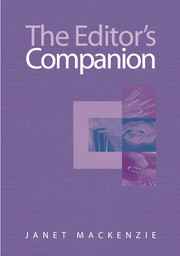Book contents
- Frontmatter
- Contents
- List of illustrations
- Preface
- 1 The editor in context
- 2 The publishing process
- 3 Management and liaison
- 4 Substance and structure
- 5 Language
- 6 Illustrations and tables
- 7 Completeness and consistency
- 8 Proofs
- 9 Editing methods
- 10 Working with documents and files
- 11 Freelance editing
- Appendix: Australian Standards for Editing Practice
- Notes
- Select bibliography
- Index
- Frontmatter
- Contents
- List of illustrations
- Preface
- 1 The editor in context
- 2 The publishing process
- 3 Management and liaison
- 4 Substance and structure
- 5 Language
- 6 Illustrations and tables
- 7 Completeness and consistency
- 8 Proofs
- 9 Editing methods
- 10 Working with documents and files
- 11 Freelance editing
- Appendix: Australian Standards for Editing Practice
- Notes
- Select bibliography
- Index
Summary
The requirements for substance and structure are discussed in Chapter 4 and language is covered in Chapter 5. This chapter explains in detail the tasks that make up the process of editing. They are divided, somewhat arbitrarily, into copyediting, language editing and substantive editing, but there is always considerable overlap and the editor may perform elements of all three on each pass through the manuscript.
Copyediting: a twelve-step program
Copyediting is the heart of the editorial process, comprising the essential tasks that must be done to prepare any document for publication–correcting spelling and grammar and checking for inaccuracies and inconsistencies. Copyediting can take place at various levels, depending on the quality of the original document and the time and money available. It includes language editing and it blurs into substantive editing. The advice given here is for the sort of manuscript that comes with the optimistic instruction, ‘It's just a straight copyedit–shouldn't need much at all.’
I present here the systematic procedure for copyediting that I apply to each job, which I vary at times, adding more steps when I need them. It's not a franchise, just a model that you can adapt to your own working methods to increase efficiency. Because every publication is different, emphasis on their similarities enables you to concentrate on the differences that are significant. By channelling your energy you increase its strength.
- Type
- Chapter
- Information
- The Editor's Companion , pp. 138 - 157Publisher: Cambridge University PressPrint publication year: 2004



